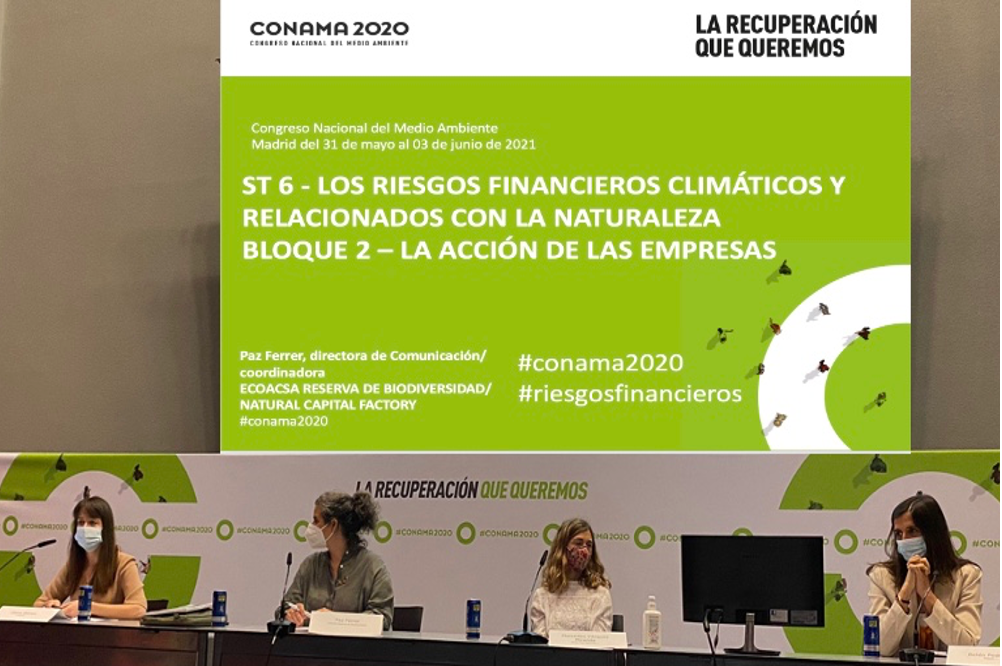The close link between climate change and the biodiversity crisis and climate and nature-related financial risks are a reality. Interest in knowing how to properly address these risks is growing, which is why the members of CONAMA’s Technical Committee 6 on “The future of climate and nature risks and their financial impact” —coordinated by members of Fundación CONAMA’s technical team and the coordinators of the Natural Capital Factory— have worked during the months leading up to the 15th edition of the National Environmental Congress (CONAMA) on various actions to help improve knowledge about these risks and facilitate their management among Spanish economic, financial and social actors.
These actions have consisted of a consultation to gather valuable information on how Spanish organizations approach the management of these risks, methodologies and tools for the identification, measurement and management, problems and solutions and opportunities associated with the adequate management of climate and nature-related financial risks and contribution of companies to adapting to climate change and strengthening social resilience to this phenomenon. Other actions developed within the framework of the CT6 work have been the organization of a webinar on how to improve climate and nature-related disclosure in collaboration with Climate Standard Disclosure Board (CSDB) and the drafting of an informative tool on the political and regulatory context of these risks and the results of the consultation.
In addition, collaboration has also been promoted with prominent Spanish actors involved in the management of climate and nature-related financial risks and business representatives to offer from their practical experience an overview on the political and regulatory framework trends and how these risks are being approached by Spanish organizations.
Political and regulatory context of climate and nature-related financial risks
The first block of the Technical Session 6 of CONAMA 2020 was focused on the political and regulatory context of climate and nature-related financial risks, the National Adaptation Plan for Climate Change 2021-2030 and the new Adaptation Strategy of the Union European. Participants were Paz Ferrer Calvo, Head of Communications of Ecoacsa and Coordinator of the Natural Capital Factory, Antonio Mateos Gil, Senior Advisor to the General Secretariat of the Treasury of the Ministry of Economic Affairs and Digital Transformation, Mónica Sánchez Bajo, Head of the Office’s Area Spanish for Climate Change (OECC) of the Ministry for the Ecological Transition and the Demographic Challenge, and Esther Palomeque, head of the European Banking Unit of the Bank of Spain.
“Our economies and societies depend on the services that nature provides and on the ability of ecosystems to continue to provide them. However, although these services are worth and estimated USD 125-140 trillion per year, nature continues to decline. According to a 2020 study by the World Economic Fund, more than half of world GDP, specifically USD 44 trillion, is depends moderately or highly dependent on nature and its benefits”
To promote greater recognition of these risks, significant efforts are being made from the regulatory sphere and also through public-private and private initiatives, which are in line with the greater demands for transparency and disclosure on the relationship between companies and the public. natural world by the investment community, consumers, and society. A recent example of this is the launch of the new Task Force for Nature-related Financial Disclosure (TNFD), whose work is based on lessons learned from the work developed by the Task Force for Climate-related Financial Disclosure (TCFD) and is aimed at solving the reporting, metric and data needs of companies and financial institutions that will allow them to better understand their risks, dependencies and impacts on nature.
Antonio Mateos Gil, Senior Advisor to the General Secretariat of the Treasury of MINECO, put in context why climate financial risks are beginning to be regulated, what is the purpose behind the current bimodal regulation (financial and environmental) and offered an analysis on the current and future national and European regulatory framework.
Explicó que «el Plan de Acción sobre Finanzas Sostenibles de la Comisión Europea parte de dos premisas: la necesidad de financiar el cambio necesario en el modelo productivo y los distintos sectores de la economía y de introducir un cambio cultural en el sector financiero sobre su funcionamiento y que pase a ser tratado como un sector más dentro de la economía.
“Several key regulatory instruments are derived from the Action Plan and are already in force. One of them is the regulation of the taxonomy of sustainable activities. In April, the first delegated acts containing the technical criteria related to the objectives of adaptation and mitigation of climate change were approved. In this case, it has been an incomplete classification because some sectors such as nuclear energy, gas, agriculture, and some manufacturing sectors have been left out. In some cases, this has been due to lack of time to process technical issues in delegated acts, in others, such as agriculture, they have wanted to wait for the approval of the new CAP, but it is expected that in the next months the adaptation and mitigation objectives are completed through the approval of complementary delegated acts that include the technical criteria of the missing sectors"
According to Mateos Gil, another relevant instrument of the European Commission’s Sustainable Finance Action Plan already is the disclosure regulation, which entered into force on March 10. “It sets obligations on asset managers to disclose sustainability-related information to their clients in relation to investments made on their behalf. Fundamentally, the regulation requires reporting on three aspects: the policy for integrating sustainability risks in the investment decision-making process, the coherence of this risk policy in connection to remuneration, and whether the main adverse effects on sustainability factors derived from that investment are being taking into consideration.”
The benchmark indixes would be a third instrument of the Action Plan on Sustainable Finance, in this case, 100% financial, which establishes the criteria to be able to create climate benchmarks avoiding greenwashing, said the representative of the MINECO.
Regulatory trends and the Spanish Climate Change and Energy Transition Law
Mateos Gil advanced a series of regulatory changes to come in the short term:
- The future of taxonomy is to develop the technical criteria for the other four environmental objectives, which will take place from next year, and then the social and governance taxonomy will be developed through delegated acts.
- The Sustainability Reporting Directive (it will replace the one previously known as the Non-Financial Information Directive), presented in April, is expected to be approved in the coming months by delegated acts throughout 2022 and 2023.
- In the second quarter of 2021, the presentation of the European green bond standard is also expected, of which it is not yet known whether it will be legislative or not, but doubts will be cleared up in the coming weeks.
- The renewed EU strategy on sustainable finance will be presented in July and will act as the new strategic framework of reference in this matter.
Mateos Gil concluded his speech by referring to the new Spanish Law 7/2021, on climate change and energy transition. “It has two major projections regarding sustainability-related financial risks. On the one hand, it establishes the obligation on the part of large companies, financial entities, and insurance companies to carry out an annual report on the evaluation of the financial impact of climate-related risks generated by the exposure of their activity, including transition towards a sustainable economy risks and measures adopted to face such financial risks. Along with this annual report, the Bank of Spain, the National Securities Market Commission and the National Directorate of Insurance and Pension Funds will also present a biannual report on climate-related financial risks.”
The importance of physical financial risks
Mónica Sánchez Bajo, Head of Area of the Spanish Office on Climate Change at MITECO, stressed the importance of physical risks and made reference to a recent EC study that assesses the economic impacts that some of the physical risks of change could have climate.
«Faced with a global warming scenario of 3 ° C, the annual loss that the EU would register would be at least € 170 billion (1.36% of EU GDP) and, specifically Southern European countries will register much higher losses than the rest of the continent. “Our success in mitigation measures will determine the difference in losses derived from climate change physical risks (...) The rate of return on investments in improving resilience is high, as every euro invested in adaptation could lead to net economic benefits of between € 2 and € 10”
The representative of the OECC also focused on the benefits of adaptation, that is, of the response we give to climate risks. According to a document published by the Global Adaptation Commission, adaptation to climate change implies the maintenance and generation of employment, above all, avoiding job losses that can pose the risks of climate change, but also the creation of employment related to adaptation measures; the prevention of the aforementioned economic losses and which is included in the Peseta IV report and the promotion of a resilient economy, which benefits the economic context. The report highlights that the rate of return on investments in resilience enhancement is high, as each euro invested in adaptation could lead to net economic benefits of between € 2 and € 10.”
Given the evidence that there is still a long way to go to significantly reduce greenhouse gas emissions, Mónica explained that several scenarios are being used to project what the trajectories of climate change could be in the future, collected in the latest report of the Intergovernmental Panel of Experts on Climate Change (IPCC), AR5.
National Adaptation Plan for Climate Change 2021-2030 and the EU Adaptation Strategy
In terms of sustainable finance, the PNACC 2021-2030 framework focuses fundamentally on the insurance activity, “because its link with adaptation is very important, since it involves a transfer of risks and can contribute to the adaptation of economic activities, for its potential to contribute to the prevention of risks and because it is an activity that can also suffer serious impacts as a result of climate change,” he clarified. A 2020 study by MITECO analyzes the vulnerability and adaptation to climate change of the insurance activity.
The PNACC identifies 18 areas, including the financial system and the insurance activity, whose objectives consist of:
- Promoting the role of the financial system as a catalyst for adaptation to climate change and continue exploring and favoring the specific contributions of the insurance activity to adaptation, with special attention to agricultural insurance, and creating incentives for risk prevention.
- Encouraging knowledge and capacities generation on the impacts of climate change on the financial system and the insurance activity, as well as on the identification of investment opportunities to contribute to adaptation to climate change.
- Promoting measures that favor adaptation to climate-related financial risks through its analysis, communication and prevention.
- Favoring frameworks for collaboration and cooperation in the field of adaptation to climate change among different agents involved in the financial system, with special attention to the insurance activity, and strengthening capacities on adaptation in the sector.
Based on these objectives, a series of lines of action are defined, among which are: the incorporation of adaptation into sustainable finance initiatives, the creation of incentives for risk prevention by integrating adaptation into the insurance activity and the strengthening of capacities on adaptation in the financial system and the insurance activity.
- Incorporating adaptation into sustainable finance initiatives.
- The creation of incentives for risk prevention by integrating adaptation into the insurance business.
- The strengthening of capacities on adaptation in the financial system and the insurance activity.
The new EU Strategy on Climate Change sets the goal of a Europe resilient to climate change by 2050, through “avoiding maladjustment and adapting to the inevitable, doing it in a faster, smarter and more systemic way.” Its text includes that “the effects of climate change pose destabilizing risks for assets and companies,” said Sánchez Bajo, and recognizes that the severity of the adaptation challenge makes it an effort by the entire government and the entire society and seeks to correct the misperception that adaptation is only a cost: it is an investment.
Finally, she advanced that the Commission will support the development of rapid response solutions for decision makers and adaptation professionals. These solutions would have to be developed according to defined time frames and with resources available for financial sector, SMEs or small farmers, etc. In addition, to accelerate action on adaptation, major private sector investments in adaptation solutions will also increase the range of options available and make them more affordable for everyone. The EU Sustainable Activities Taxonomy encompasses adaptation and will act as a facilitator and incentive to channel private finance towards greater resilience to climate change.
The role of the banking supervisor
Esther Palomeque, from the Bank of Spain’s Regulation Department (European Banking Unit), stated that in the last two years, almost all international prudential supervision forums have analyzed how climate and environmental risks impact credit institutions. A consensus has already been reached, in fact, this April the Basel Committee, the main forum for banking prudential regulation, published a report on climate risk factors and transmission channels in which it explores precisely how climate-related financial risks emerge and how do they affect both banks and the banking system.
One of the consensual conclusions is that climate risks are not new, but rather increase other existing prudential risks such as credit, liquidity, market, operational or reputational risks.
Palomeque added that an article by the European Central Bank published in the Financial Stability magazine of May 2020 recognizes that climate-related financial risks are material for the banking sector and that the Bank of Spain is working from different perspectives in this area. For example, in reducing its own carbon footprint, and how to incorporate sustainability into monetary policy portfolios or investments in reserve portfolios. As a prudential supervisor, the Spanish supervisor is participating in international forums and organizations where different task forces have been created in recent years to address how climate risks affect the banking sector. Efforts are also being made to increase the awareness and sensitization of the banking sector on the importance of these risks.
According to Palomeque, one of the problems is the lack of information and data to be able to carry out an adequate analysis on the extent to which banks are affected by these risks. The revision of the Non-Financial Information Directive is expected to bridge this gap to some extent.
“The Bank of Spain is working on carrying out stress testing to assess the resilience of the banking sector to climate risks and, specifically, transition scenarios are being assessed. It is very likely that the report including the results will be published in the second half of the year. Additionally, the Spanish Law on Climate Change and Energy Transition states that the Bank of Spain, the CNMV and the National Directorate of Insurance and Pension Funds have to prepare a report every two years on the effects of climate risks on financial stability”
International sphere
Esther Palomeque assured that Network for Greening the Financial System (NGFS), created in 2017 to develop good practices in climate and environmental risk management, published in May 2020 a guide on how to integrate these risks into supervision; and in June it released another report on scenarios that is under review and the revised version will be probably published by the end of the year.
The Financial Stability Board (FSB) is also working in this area, whose recommendations have served to provide global consistency of climate risk disclosure frameworks and supervisory and regulatory approaches and have been supported by the G20 and the Basel Committee, chaired by the governor of the Bank of Spain. The Basel Committee has published two reports on risk factors and transmission channels and another on methodologies for measuring climate risk. Now they are working in how the incorporation of these risks can be approached by the prudential framework. The European Central Bank published in November 2020 a very detailed guide on how banks are expected to manage and disclose environmental risks, which are very much in line with the expectations developed by the Bank of Spain. The ECB is working on a stress testing on climate change risks in banks by 2022 and the European Banking Authority (EBA or EBA) has launched an NGFS on the framework for disclosing these risks and a preliminary report on how to they must manage.
In the words of the expert of the Spanish banking supervisor, “the expectations published by the Bank of Spain were developed with the aim of making the financial sector aware of the relevance of addressing these risks and of conveying the message that they have come to stay, for what they have to understand and manage them appropriately.”
Expectations recommend the incorporation of financial climate and environmental risks in the strategy and business models, taking into account that they manifest themselves in longer time horizons than those usually used in strategic planning. In relation to corporate governance, the board of directors is ultimately responsible for integrating these risks into the general strategy and internal organization of the entity. The importance of comprehensive and global risk management is mentioned, in which they must be integrated into existing policies and procedures, and into scenario analyzes, stress testing and data availability.
Challenges
For Esther Palomeque, the main challenges that banking supervisors have to face are:
- Need for reliable and comparable climate data.
- Importance of having adequate methodologies for measuring these risks.
- Importance of advancing and developing adequate management practices for these risks.
- Incorporation of these risks in prudential frameworks.
CONAMA 2020: Climate and nature-related risks: Business action








No Comments
Sorry, the comment form is closed at this time.